PARTY TABLE SETTINGS
What better way to
trade the gloomy winter chill for warm holiday cheer than with an old-fashioned holiday
dinner party? It’s a time for sparkling little lights, flickering candles, everyone
dressed in their holiday best, and the warm laughter of family and friends.
But this scene may not accurately describe the holiday parties in your own home, which
could tend more toward a pile of wet boots by the front door and the cousins in their old
t-shirts staring at the game on TV while you scrub out the roasting pan and complain about
your sister-in-law’s baked squash. Again.
One way you can break out of the holiday routine is by hosting a formal dinner party.
That’s right. Formal, as in everyone has an excuse to wear their holiday best, the
party manners are taken out of the closet and dusted off, and everyone goes home with a
little shiny glow of formality. |
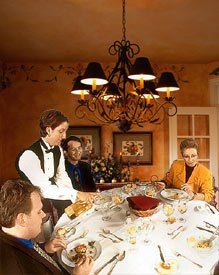 |
The first step is to draw up the guest list. Don’t rely on the regular old gang
alone; the trick to making interesting conversation is to invite a few people you know
well, and a few newer friends. Don’t worry about hurting the feelings of a few people
you “always” invite. This is a brand-new tradition you’re making, and so
the fact that your brother-in-law the bore is not on the list shouldn’t matter.
You’ll still have your regular event to which everyone comes; this party is something
different. The new blood will also help encourage a feeling of formality, the people who
already know each other will be on their best behavior, and will be less likely to lapse
into old familiar jokes and the same old boring conversation.
But make sure you invite enough new guests so they don’t feel they’ve just been
tossed into the fray, and when introducing people to one another, make sure to mention
something interesting about each person. Don’t just say, “This is Eleanor.”
Instead, say, “This is Eleanor, who I teach with at the elementary school; she’s
a violinist.”
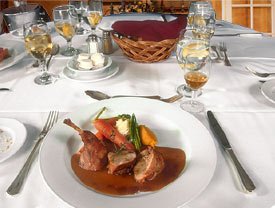 |
One advantage to
hosting a formal dinner is that you can use place cards, which you can buy in any
stationery store, or you can make yourself using plain white watercolor paper and folding
it into a small card with each guest’s name written on it.
When you’re deciding
where to seat your guests, don’t be afraid to break up the regulars and mix them in
with the new people, and don’t be afraid to split couples up – being careful not
to place the pretty single gal right in between two guys you know are having marital
problems. Remember, too, that it’s probably more important who sits across from whom
than who sits next to whom, unless you have an impossibly wide dining table.
|
Once you decide who’s coming to dinner and where they will be seated, think about the
table decorations. This is the time to break out your grandmother’s white tablecloth,
unless of course the very thought of that makes you too nervous. Even at a formal dinner,
you want to be relaxed, and the more relaxed you are, the more relaxed your guests will
be. So if the thought of someone spilling red wine on the tablecloth will make you stand
at attention with a spray bottle of bleach in one hand, choose something else. Chances are
you can get a white tablecloth at a discount store, and that way you won’t be so
concerned.
If you choose a cloth with a pattern, make sure that in the tablecloth, napkins, and
placemats, you don’t have too many conflicting patterns. There will be enough going
on with all the plates, silverware, and napkins, and you want everyone to be able to
actually find the little dessert fork. A tablecloth with a floral pattern should be
matched with white linen napkins, or with napkins in a solid color matching the pattern.
The formal place
setting has a “service plate” which is later removed when the first course is
served, and utensils are laid out to the right and left of it. Silverware for dessert is
either brought in with the dessert course or it can be set out in advance, making for more
of a glittering array of utensils.
When you’re thinking of creating a formal dinner table, remember that there is a
reason for the rules; the place settings should be designed to help each guest better
enjoy the meal, rather than to intimidate. If you bear in mind that the place setting
rules have their own logic, it will be easier to remember them.
|
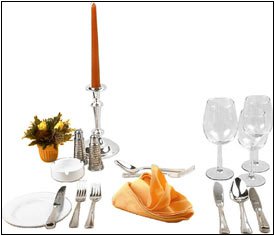 |
To give everything a very tidy look, place the silverware one inch in from the edge of the
table. All the silverware is arranged according to chorological use; here in America, we
eat the salad first, so the salad fork is on the outmost edge of the left hand side of the
plate, followed by the dinner fork and then the dessert fork. Same thing on the right hand
side, so that the guest works toward the plate as the meal progresses.
The all-important water glass is just above the knife, with the wine glass – or
glasses, if red and white will both be served – to the right of it.
Even if you’re not having such a formal dinner party, there are a few rules to bear
in mind in setting the table.
While you don’t have to measure precisely, make sure the table is neatly arranged.
Keeping the tablecloth, placemats and napkins simple will help with this. Sometimes having
napkins and a tablecloth–and placemats, as well–all in one solid color can make
for a very elegant look.
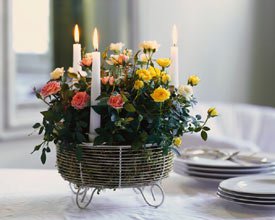 |
Another way to pump
up the elegance at your dinner party is by creating a centerpiece that’s beautiful
yet understated. Make sure to keep it low, no more than about 5” high if you plan to
keep it on the table throughout the meal.
At any time of the year, a shallow bowl with
flower heads such as roses floating in it will give the table a festive feeling without
overwhelming the guests with a big bouquet around which they must peer to try to converse
with the people across the table.
|
For winter holidays, greenery of some kind is a big hit,
no matter what religion you’re focusing on; holly and ivy intertwined in a white,
red, or silver bowl will add some holiday color, and little candles in glass cups will
lend a festive, celebratory feeling.
One centerpiece that will be sure to please your guests, no matter what their favorite
religious holiday, is a bowlful of frosted fruit–and it has the advantage of being
easy to put together at the last minute.
First, choose small bunches of grapes, peaches, and plums, and cut off any stems that
don’t look fresh. Then, beat an egg white and mix it with 2 tablespoons of water.
Next, dip the fruit into the egg white, covering the parts of the fruit that you want to
be frosted. Finally, dip the fruit in sugar, tapping off the excess, and lay it on wax
paper to dry. In candlelight, the fruit will shimmer, making a magical holiday table
arrangement without any waste: you can eat the fruit at the meal’s end!
One item for the
table that can contribute to the air of formality is the water pitcher. One of the most
common mistakes made by the novice dinner-party host is to skimp on providing water with
the meal. Especially if the guests have had a before-dinner drink and are having wine with
the meal, they need water so they won’t be staggering through the dessert course. So
be sure that just before everyone is seated, the water glasses are filled, and a pitcher
of water should remain on the table. This also gives you an opportunity to dress the table
up a bit, with a water pitcher in cut glass.
Likewise, make sure there are enough salt and pepper shakers and butter dishes. A group of
eight people needs two sets of each.
In any room, the lighting is of utmost importance, but especially when you’re trying
to generate a more formal mood. One of the most popular lessons in the Sheffield Course in
Interior Design is the one on lighting, and that’s because the mood of a room is so
quickly changed with lighting–for better or worse. You can’t just light the
candles and leave the overhead on and expect your guests to relax.
|
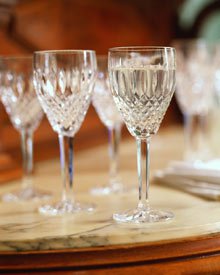 |
For the best results, test out your lighting plan a few nights before the party, to make
sure you have enough light so people can see each other and see their food, but so that
everyone is bathed in that flattering, warm glow from the candlelight. To achieve this,
you’ll need to play with a combination of the candlelight, light from an adjacent
room, and light from small lamps in the dining area.
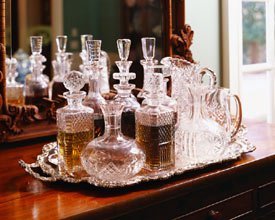 |
Of course, using that
old social lubricant, alcohol, still works wonders.
But what if you’re invited to a formal dinner? How do you behave properly without
choking?
First of all, relax. Remember that everyone there is just out to have a good time, to
enjoy the pleasures of good food, good wine, and good company. Be friendly, ask other
people about themselves, and don’t raise your voice.
When you’re first seated, place your napkin in your lap as soon as you are seated. If
it’s large, fold it in half first. If you must leave the table mid-meal, leave it on
your chair. When the meal is over, put it to the left of your plate. |
At a formal dinner, the waiter will serve each guest in turn, usually ending with the host
or hostess. Once you have been served, watch the other guests; do not begin eating until
everyone is served. If it’s a very large group, or if there’s a long lag time
before the hostess is served, she may signal you and the other guests to start eating. In
this case, do begin, but eat slowly.
How do you know, once
you’re seated, which of those plates and glasses is yours? At a truly formal dinner,
there won’t be a bread plate; the small plate to the upper left of your dinner plate
is your salad plate. If you’re in doubt, wait until the waiter puts something on it.
The rule is, eat to your left, drink to your right: your small plate is to your left, and
your glasses are to your right. If you find that your neighbor has used your bread plate
or wine glass by mistake, don’t embarrass him by pointing it out; instead, quietly
ask the waiter for a new one.
The waiter will serve to your left and clear from your right. If you want anything, wait
until he or she comes around to you again; if you’re in dire need, signal by
discreetly raising one hand, with the forefinger raised. The wait staff at a truly formal
event will be so good at sighting a diner in need that you won’t need to shout out
“hey, buddy, couldja bring me another brewski?”
Whether you’re throwing a party at your three-room apartment or attending a lavish
affair at the home of a leader of a powerful Western country, most of all remember that
the point is to have a good time and enjoy the luxury. You’ll be back to mac and
cheese in front of the TV soon enough. |
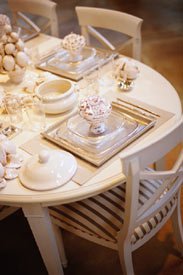 |
Reprinted
with permission from the New York Institute of Photography website at http://www.sheffield.edu
As always there are differing
views as to what is correct procedure, Mr. Bob
Moffat has kindly sent me the following comments -
"If you excuse
yourself from the table, loosely fold the napkin and place it to
the left or right of your plate. Do not refold your napkin or wad
it up on the table either. Never place your napkin on your
chair." (From Dining Etiquette Guide)
Copyright © 2000-2020
Hints and Things
and © 2002
Sheffield School of Interior Design
All Rights Reserved.
No portion of this site may be reproduced or redistributed without prior
written permission from Hints and Things. All trademarks & copyrights
throughout Hints and Things remain the property of their respective
owners.
Hints and Things cannot be
held responsible for any information given on this site nor do they
necessarily agree with, or endorse, the views given by third parties.
|

